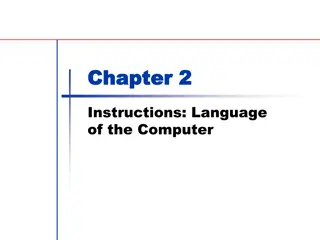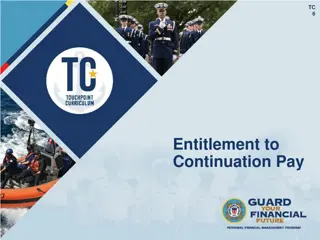Policy Discussion for Continuation of Operations Plan - City of Madison
This policy discussion focuses on developing a Continuation of Operations Plan (COOP) for the Office of the Independent Monitor in the City of Madison. The aim is to prepare a draft policy by assessing risks associated with staff absences and devising strategies to mitigate those risks. Steps include assessing fully staffed operations, identifying critical services, and understanding the risks of not providing non-critical services for 1-4 months.
Download Presentation

Please find below an Image/Link to download the presentation.
The content on the website is provided AS IS for your information and personal use only. It may not be sold, licensed, or shared on other websites without obtaining consent from the author.If you encounter any issues during the download, it is possible that the publisher has removed the file from their server.
You are allowed to download the files provided on this website for personal or commercial use, subject to the condition that they are used lawfully. All files are the property of their respective owners.
The content on the website is provided AS IS for your information and personal use only. It may not be sold, licensed, or shared on other websites without obtaining consent from the author.
E N D
Presentation Transcript
Policy Discussion of Continuation of Operations Plan for the Office of the Independent Monitor City of Madison, Police Civilian Oversight Board Policy and Procedure Subcommittee 7/11/2024
What are we trying to do here? To leave this discussion with a clear outline of a Continuation Of Operations Plan (COOP) so that a draft policy can be prepared for editing and review Assess likely risks that staff absences would exacerbate Develop strategies for mitigating those risks The purpose of a COOP is to ensure the OIM can handle temporary absences. Several services could become critical if left unprovided for extreme lengths of time. For the purposes of this policy, I suggest we limit the scope of this plan to hypothetical absences of 1 to 4 months.
Step 1: Assess Operations of a Fully Staffed OIM Staffing the PCOB Meetings Receiving Complaints Continuing open investigations Completing Finance/Payroll Email correspondence Coordination between Office and Board Generating Reports Appointing attorneys Making recommendations to the Chief Referring cases to PFC Policy Recommendations Community Outreach Accessing MPD records Anything else?
Step 2: Identify Critical Services Definition: A Critical Service is a task or obligation of the OIM that cannot be stopped at any point without materially harming the OIM s ability to fulfill its duties Non-Critical Services would be any service that can be delayed or paused for 1 to 4 months (though not indefinitely) and would NOT materially harm the OIM s ability to fulfill its duties
Proposed Critical Functions Staffing the PCOB Meetings Receiving Complaints Continuing open investigations Finance/Payroll Email correspondence Coordination between Office and Board Appointing attorneys
What are the risks of NOT providing non- critical services for 1-4 months? Opening new investigations: Urgent critical incidents wherein evidence may be lost if not acquired immediately Generating Reports: Delays Making recommendations to the Chief: Temporary lack of OIM input Referring cases to PFC: Urgent critical incidents wherein evidence may be lost if not acquired immediately Policy Recommendations: Temporary lack of OIM input Community Outreach: Loss of public interest and engagement Accessing MPD records: None, due to Record Retention laws
Before we move on, any Thoughts? Changes? Notes?
Step 3: Strategies for Mitigating Risks Posed by Non-Critical Services Opening new investigations: In the event of the IM s absence, new investigations should not be opened. However, data-based investigations would theoretically be able to continue with the DA. Some complications may arise over access to records but can likely be solved through procedures consistent with the MOU. If an urgent and immediate need exists to open a complaint investigation within 30 days, the Board should select and hire an LTE who will retained for some time after the IM s return. Generating Reports: Collaboration between IM and DA will provide redundancy in the event of a deadline/emergency or final edits Making recommendations to the Chief: This is a service shared by the Board so, in the event of the IM s absence, the Board can continue to provide this service Policy Recommendations: Service shared with the Board.
Step 3: Strategies for Mitigating Risks Posed by Non-Critical Services Referring cases to PFC: Referral comes after a complaint has been received and reviewed. Referral guidelines can be established for staff to follow and cases outside of the guidelines will remain paused until the IM s return or temporary replacement by LTE. In the event of extenuating circumstances, the Board and a representative of the City Attorney s Office should meet in closed session. Community Outreach: Service shared by the Board Accessing MPD records: Per the restrictions of the MOU, the IM is the nexus for these records to the OIM and Public. In the event of an IM s temporary absence, and an urgent need for records arises, coordination between the Board, MPD, and OCA is strongly encouraged.
Step 4: Assignment of Critical Responsibilities Responsibilities Independent Monitor Office Manager x Data Analyst Staffing the PCOB Meetings Receiving Complaints Continuing open investigations Finance/Payroll Coordination between Office and Board Appointing attorneys Email correspondence X X X x X X X X
Step 4: Assignment of Critical Responsibilities Responsibilities Independent Monitor Office Manager x Data Analyst Staffing the PCOB Meetings Receiving Complaints Continuing open investigations Finance/Payroll Coordination between Office and Board Appointing attorneys Email correspondence X Can do Can do X Can do X Cannot do Cannot do X X Discouraged Can do X Can do X Cannot do Cannot do Limited Capacity X Can do
Step 4: Assignment of Critical Responsibilities Responsibilities Independent Monitor Office Manager x Data Analyst Staffing the PCOB Meetings Receiving Complaints Continuing open investigations Finance/Payroll Coordination between Office and Board Appointing attorneys Email correspondence X Can do Can do X Can do X Cannot do Cannot do X X Discouraged Can do X Can do X Cannot do Cannot do Limited Capacity X Can do
Flow Order of Critical Responsibilities Responsibilities Independent Monitor Office Manager 1 Data Analyst Staffing the PCOB Meetings Receiving Complaints Continuing open investigations Finance/Payroll Coordination between Office and Board Appointing attorneys Email correspondence 2 3 3 1 2 1 2 1 2 1 3 1 3 1 2
Step 5: Strategies for Continuing Critical Services Dependent on the Independent Monitor Continuing Open Operations Pause? Decision Matrix LTE Independent Contractor hired by Board? Qualifications of a Contractor? Appointing Attorneys PCOB Leadership as backup for this task?
Step 6: Training and Testing (and Revision) Board, if IM is absent: Hiring of LTE; Appointment of attorneys Cross-Trainings of the following across all staff: Staffing Meetings; Receiving Complaints; Board Coordination; Email Management Cross-Training between Monitor and Manager: Finance/Payroll Testing: The COOP will serve as the regular flowchart of critical services in the instance of scheduled absences as well. For example, if the Office Manager is on vacation, the Data Analyst will be primary on Email Correspondence
Flow Order of Critical Responsibilities Responsibilities Primary Secondary Tertiary Staffing the PCOB Meetings Receiving Complaints Continuing open investigations Finance/Payroll Coordination between Office and Board Appointing attorneys Email correspondence OM IM DA OM DA IM IM Board Backup OM IM City Backup OM IM DA IM Board Backup OM DA IM
Next Steps 1. Synthesizing Notes of Board Input 2. Create First Draft of Policy 3. OCA Review 4. Bring Draft to P+P Subcommittee on 8/1 5. Bring Draft to Executive Subcommittee on 8/22 6. Final Edits 7. Bring to Full Board on 8/29























